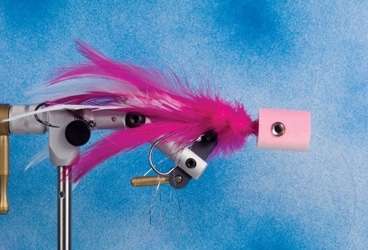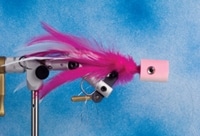
billfly-4
Artistic value and aesthetics aside, world record holder and avid billfisherman Jeff McFadden showed me a way to build and rig a no-nonsense billfish tube fly that is extremely effective. Like most of these flies, it’s simply a collection of feathers tied around a tube. As a result, you can easily attach it to a pretied big-game leader while you’re out on the water, so it isn’t necessary to carry flies that are already rigged on a leader stretcher. This is a real plus in this day and age of travel restrictions. Since McFadden carries them unfinished and unrigged, he can create a fly that works in a variety of conditions depending on his current need. If he wants a topwater pattern, he adds a popper head. If he’d rather throw a subsurface fly, he wraps some lead around the tube and quickly glues it in place. He can even put two flies together to create a longer one for bigger fish. Once they’re tied, McFadden stores his tube flies in a plastic bag and keeps his pretied leaders loop-to-looped on a spare spool, ready for final rigging.
He makes this fly by simply tying several layers of schlappen – it doesn’t even have to be the highest quality feathers – onto a tube. I highly recommend getting a tube fly jig for your vise (www.hmhvises.com) to make the process easier. Although you can easily incorporate flash material between layers of feathers, McFadden prefers to tie his flies without it and he always uses solid pink hackles. However, I’ve tied the one shown here in pink over white with some silver Flashabou.
The best thing about this no-nonsense billfish fly is that you can easily create a dozen of them in an hour or so at your bench. In fact, it probably takes longer to build the IGFA leaders than it does to tie the fly. Also, the materials are actually inexpensive, and while the fly looks decidedly plain no one can argue with McFadden’s world-record results.
For final rigging McFadden threads a leader through the tube and then attaches his hooks to the shock tippet using aluminum crimps and a crimping tool rather than tying them on. He prefers this method because it allows him to precisely control the length of his shock material in case he wants to submit a potential world record. I just snelled a pair of hooks to the shock tippet for this pattern. You can also buy or prepare a stiff tandem hook rig and tie that to the end of the shock tippet behind the fly as well.
Materials
HOOK: 2 6/0 Owner all-purpose bait hooks or equivalent
THREAD: 3/0 flat-waxed nylon
BODY: Pink and white schlappen
FLASH: Silver and pink Saltwater Flashabou
HEAD: Rainy’s popper head (optional)
TUBE: 2 inches of 1¼8-inch plastic fly tubing
WEIGHT: Lead wire (optional)
GLUE: Super glue and epoxy
Tying Instructions

Step 1: Using a tube fly jig for your vise, prepare a piece of plastic tubing about 2 inches long. Beginning at the very rear of the tube, tie in several bundles of white schlappen feathers (at least six, but more is better), making sure to surround the entire tube. Wrap securely and glue well. If you want to add flash, do so at this point along both sides of the fly.

Step 2: Tie in a similar bunch of pink schlappen just in front of the white feathers, secure well with thread, and glue. You can continue to add feathers in this manner until the fly is the length you want and as full as your prefer, but two sets should suffice for sailfish. Add two more small bundles of flash along the sides if desired, whip-finish and glue.

Step 3: Epoxy the wraps and let it dry completely. Trim the tube so that it extends no more than 1¼2 inch from the feathers and epoxied head. To make the fly float, add any style of large popper head you want; McFadden prefers to secure them with glue so they stay put. If you prefer to make a subsurface fly, simply wrap lead wire around the exposed tube and glue thoroughly to secure.

Step 4: Slide the shock tippet of your prerigged leader down through the tube and Snell or otherwise attach a pair of 6/0 hooks to the tippet so they do not extend past the longest material on the fly. For IGFA regulations, make sure that the distance from the knot at the hook to the top of the shock tippet does not exceed 12 inches.
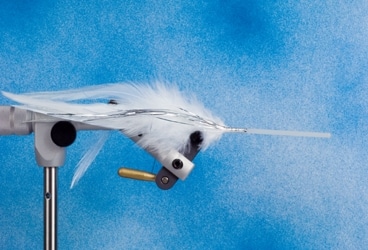
Tying the Billfish Fly
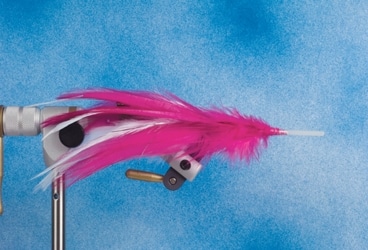
Tying the Billfish Fly
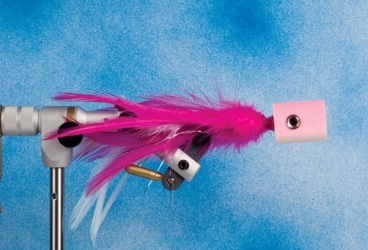
Tying the Billfish Fly
